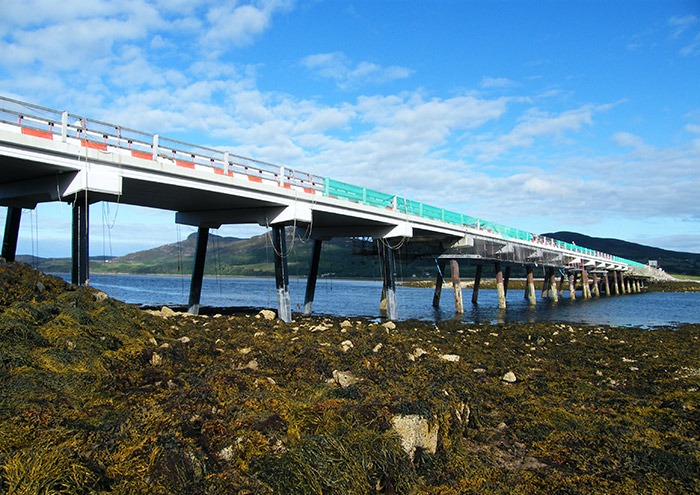The Kyle of Tongue Bridge in Northern Scotland opened in 1970. It has an overall span of 184m consisting of 18 approximately equal spans. Prestressed concrete beams form the deck, with reinforced concrete pile caps supported on steel piles. The bridge links the eastern and western side of the sea inlet and was built to replace a ferry service.
Location
Client
Completed
Structure

The bridge was suffering corrosion due to exposure to high concentrations of chloride from the sea and de-icing salts used on the deck and in 1989 patch repairs were undertaken. However, inspections from 1999 onwards reported that corrosion was still continuing both on the prestressed concrete beams and reinforced concrete pile caps with evident structural deterioration.
Chloride sampling throughout the structure indicated concentrations exceeding 1% by weight of cement at the depth of reinforcement indicating a high risk of corrosion.
Traditional electro-chemical corrosion control techniques, such as permanently impressed current cathodic protection, could induce hydrogen embrittlement of the prestressed strands unless the level of steel polarisation was strictly controlled.
A solution was sought which removed this risk whilst delivering effective, long term corrosion control.

Overseen by AECOM, CPT designed a DuoGuard™ hybrid anode system to protect the prestressed steel in the deck beams and prevent further spalling – the first time a hybrid anode system had been used for this purpose. The term ‘hybrid anode’ refers to an anode which can be used in both impressed current and galvanic/sacrificial modes.
Using an external power source, a temporary impressed current was applied to stop active corrosion and render the steel passive. Specially designed voltage and current controllers helped to regulate the current. The DuoGuard anodes were then disconnected from the power source and left in place to self-generate a galvanic current, sufficient to maintain steel passivity and control corrosion.
The galvanic current cannot polarise the prestressed stands to the extreme negative levels at which hydrogen embrittlement can occur.
Away from the pre-stressed deck beams a number of localised patch repairs were required to the traditionally reinforced in-situ capping beams. PatchGuard™ galvanic anodes were installed at the boundary of repairs to counter the so called ‘incipient anode’, or ‘ring anode’ effect whereby corrosion propagates immediately outside the patch.
PatchGuard anodes are installed in the surrounding concrete rather than the traditional approach of embedding sacrificial anodes within the patch repair. This ensures that protective current is delivered directly to the steel outside the patch, which is at the greatest corrosion risk, as opposed to the clean steel within the patch repair.

DuoGuard anodes, installed to chloride contaminated areas of the prestressed deck soffit, are self-powered after the initial charging phase, thus minimising future maintenance requirements and associated life costs.
Independent monitoring by Aecom demonstrated that the steel in the four monitored zones was passive 1,000 days after DuoGuard installation to the pre-stressed deck beams.
Furthermore, the open circuit steel potentials taken over the period demonstrated a trend to more positive values, suggesting that the reinforcement is protected and in a passive, benign environment.
PatchGuard anodes, installed at the perimeter of the capping beam repairs, are compact, simple and quick to install causing minimum disruption. Placed within the host concrete for enhanced current distribution, PatchGuard anodes provide low maintenance, low cost, long term corrosion protection – extending the life of concrete repairs.


Patchguard™ Galvanic Anode, the unique corrosion repair solution for patch repairs.
Find out more
DuoGuard™ Hybrid Anode halts reinforced concrete corrosion for targeted protection.
Find out moreFor assistance and guidance from the industry experts please leave your details below and we’ll be in touch.